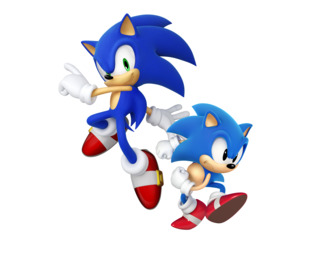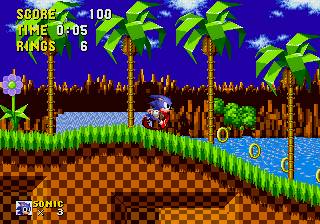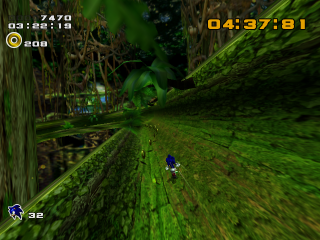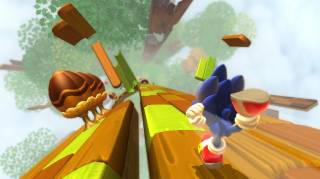Green Hills and Running Shoes
By gamer_152 2 Comments
Recently, we received the latest chapter of Sega’s high speed rodent-based platforming series in the form of Sonic Lost World, and the reception has been less than favourable. A relative few say they’re enjoying the game, while many see it as yet another failed Sonic title, and some others are just finding it below expectations. It’s been said plenty of times before, but I think it bears repeating that you’re probably not doing yourself any favours if you’re getting hyped up for a new Sonic release as some sort of return to form for the franchise, and then getting disappointed when it doesn’t live up to those expectations. We’ve seen multiple occasions on which Sonic has been doing pretty poorly for itself, but developers or fans have pointed to a new Sonic game on the horizon, speculating or proclaiming that it will return the series to the old school roots everyone loved, then when the game has actually rolled around it’s just not been that impressive. That’s not to say that there haven’t been some promising-looking Sonic games that have turned out well, but there have also been many that haven’t, and this idea of Sonic just reverting itself to its classic 90s state overnight is a bit of a pipe dream.
Personally, I think I’ve been a bigger fan of the post-90s Sonic than most. For example, I have a special place in my heart for Sonic Heroes as a ridiculously upbeat and colourful experience, and as insane as it may seem I even enjoyed Shadow the Hedgehog at the time. However, it’s clear that Sega have struggled with trying to bring the blue blur into the age of modern gaming, and that Sonic simply doesn’t command the respect he once did.
A Bygone Era

In a way Sonic’s decline felt almost inevitable. Sonic himself, with his extreme speed and flippant attitude, was unmistakably a product of the 90s, and Sega’s exact place within the 90s games industry. As a character, Sonic doesn’t just embody the lightning-fast pace of much of series’ gameplay, but was also meant to be a reflection of exactly how fast Sega’s consoles were, or more to the point, how much faster they were than Nintendo’s. Sonic’s attitude matches an era when Sega weren’t afraid of directly calling out the competition, and they needed a masthead for their fierce involvement in the console market. His hip, edgy image was both one of his keys to success and one reason for his waning popularity in more recent years.
It’s easy to see how among the kids who made up the large majority of gamers at the time, Sonic’s trendy and in-your-face attitude seemed much more appealing than the gentler, family-oriented Mario, but in an age where Sonic isn’t the face of a shiny new console and the 90s are long dead, it seems natural that Sonic is not as relevant as he once was. Sega have tried to jazz up the series, reinventing their spiny speedball as a werewolf, giving him a sword, pairing him with a dark and brooding counterpart, but it’s all come as a bit of a reflection that Sonic has never had the almost Disney-like timeless quality of Mario. Similarly, while Mario’s dialogue and stories have remained largely minimalist, Sonic has taken on a more fleshed-out approach to story that’s not gone down well. Going from a very light approach to narrative, to a deeper and fuller one, can be a very dividing thing for audiences. Sometimes characters turn out to be not who we thought they were or who we want them to be, and it becomes all the harder to ignore bad writing when it thrusts itself into view more frequently and intrusively. A lot of video games have rather bland stories and characters, but Sonic and his surrounding cast are often outright irritating. I have a suspicion that this may be because Sonic is still being written for kids, and that we’re just not the target audience. Either way though, the potential problems with the games run deeper than this.
Building for Speed
It’s been asked before whether Sonic was genuinely that good in the first place or whether we’re just looking at it through rose-tinted glasses. Some have made the statement that Sonic only ever consisted of holding right and occasionally pressing A, and that it never had that much depth or variation. To some degree I think the version of old school Sonic in many peoples’ heads doesn’t quite fit the reality; across the board we have a tendency to idealise the games we are nostalgic for. It all starts to get very subjective at this point though. Not only would we all have a different experience with those games if we went back to them today, but for fans to form a collective consensus on how well those games hold up would require us replaying them on a scale that probably isn’t going to happen.

What I can say is that you don’t have to spend long with the original Sonic games to see that they were more than just constantly running to the right and periodically hitting a single button. You might not think that if you just played the first couple of acts of Sonic 1’s Green Hill Zone, and it is true that the games have you frequently zooming around levels with little control, but they’re also full of legitimate platforming sections, with the first Sonic in particular requiring quite no small amount of precision platform jumping once you’ve gotten beyond the opening levels. Pressing right and A simply wouldn’t get you from the beginning to the end of a Sonic game, and in a lot of situations would be just as useless as it would in any other platformer. Of course, that doesn’t mean the argument can’t be made that Sonic relies too much on sections where you’re given little or no control, or that it doesn’t have other potential problems.
Personally, I think 2D Sonic is usually at its best when it’s falling back on moments of high velocity traversal with little player input, and is often at its worse when it’s asking for slow and exact movements. The controls are always at least serviceable for regular platforming sections, but not much more than that. This might well be one of the reasons that Sonic 2 onwards contain more periods of high momentum and fewer precision-based sections than 1. You see, while Sonic’s speed can be exhilarating, it does give the developers a few problems. It’s very difficult for example, to build a jump that gives players a lot of lift and distance when they’re going fast, but is controlled and precise when they’re going slow or launching from a standing point. When the designers move a player very quickly through a level it’s also hard for the player to A. Get a good read of what’s on-screen, and B. React quickly, accurately, and precisely to upcoming obstacles, which essentially leaves Sonic with three modes to operate in: Players not going very fast, players going fast but there being little challenge, or players going fast but being given next to no time to react to obstacles put in their way. Due to the huge difference between Sonic’s top speed and bottom speed, and the way you’re meant to gradually build up to maximum speed, hitting obstacles or otherwise coming to a stop also breaks the pacing in Sonic in a way it just doesn’t in other games.
I believe whether 2D or 3D, some, if not most of the problems we’ve seen surrounding the Sonic games have been caught up in these aspects of their design. Still, while the old school Sonic isn’t perfect, it is in my opinion still fun, and sometimes those moments of simply running to the right and pressing A are enough. However, a lot of people feel that Sonic began to fall apart after it made its transition into the three-dimensional, and the series’ use of speed may have played a major factor in that.

Again, the faster you have Sonic move, the less precise the control is going to be, and while that’s not as much of a problem in the 2D games where you’re just running either left or right, the multi-directional nature of moving a character in 3D space means that something more precise is often required for 3D games. It’s difficult for the designers to create a Sonic that moves slowly and carefully enough to let you properly navigate a full 3D environment, but that accelerates fast enough so that you can quickly go from standing still to moving at high speeds. These control issues give the designers greater impetus to make the 3D Sonic a more tightly guided experience, and provide you with less freedom of movement than in other 3D platformers. You can see this in the way that the more open levels of Sonic Adventure and Sonic Adventure 2 were phased out for the games to be focused solely around the rollercoaster-style level design we saw from Sonic Heroes onwards. Again, my opinion is that the 3D Sonic’s best bits are often the more tightly guided sections, but sometimes the precise platforming in the 3D games has been even less desirable than in the 2D, and it’s not hard to see where fans may have been soured by these gameplay experiences.
A Division
There was generally more understanding for Sonic when it was still trying to find its feet in the three-dimensional world, but at a certain point Sega stopped getting the benefit of the doubt. It also didn’t help them that Nintendo managed to basically master the 3D platformer overnight with Super Mario 64. In fact, Nintendo’s general knack for creating great 3D games out-of-the-gate was uncanny. Of course, Sega have no doubt noticed the prevailing message that’s come from many Sonic fans over the past decade or so, that people want a return to the classic 2D Sonic, but this looks to be easier said than done. There have been some attempts to break from the 3D formula in the last few years, but quality and commitment to this idea has wavered. Sonic the Hedgehog 4 was an honest-to-God attempt to make a new game in the style of the classic Sonic, but while it might have looked great on paper, for many, the physics, controls, and level design just weren’t up to snuff, and Sega obviously weren’t optimistic enough about it to put out more than two “episodes”, the second of which was very poorly received. Sonic Generations and Sonic Lost World tried to pay homage to the beloved 2D Sonic through heavy use of 2D platforming sections, but still insisted on clinging to their 3D gameplay for much of the time.
You might well ask that with so many people wanting the old school 2D Sonic and Sega obviously being willing to produce it up to a point, why don’t they just go the whole hog with it? There are a few different theories you can throw out there for this one, but from the sales figures we can see that as much as we may gripe about the decline of Sonic, there is still a pretty large audience for current Sonic games. Most 3D Sonic games sell over 1 or 2 million copies, and even the often derided Sonic Unleashed sold 2.48 million units. This paints the picture that, in part, Sonic might be getting made for a different, newer audience, and that’s why a lot of Sonic isn’t gelling with us. Sega obviously still place worth in the more traditional Sonic fans, but right now appear to be tackling the demanding task of trying to find a pleasing middle-ground for everyone between the newer, sleeker Sonic of the modern era, and the classic retro Sonic that other fans have been crying out for.

This franchise would be much easier to deal with if Sonic was just good or just bad, but for many of us there’s been an inconsistency in the quality of the games which has made it more complicated. Some elements of Sonic are fun, others aren’t so much. Some Sonic games look like they could represent a true upturn for the series, others turn out to be junk. With a grating modern image, a new audience to cater to, and a host of potential gameplay issues, it’s hard to see Sonic ever rising from the ashes in the way we want him to, but Sega’s speed freak might not be a complete write-off. The way I see it, getting our hopes up for future Sonic titles might be a dicey proposition, but that doesn’t mean that we should rule out the possibility that once in a while the series might produce a pleasant surprise. On a personal level, I do think there’s something to be enjoyed in the 3D Sonic, and Sega have proven themselves capable of releasing some at least reasonably fun games when they can get things right. Thanks for reading.